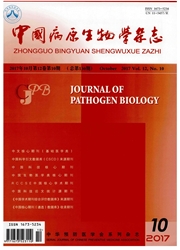

 中文摘要:
中文摘要:
目的观察旋毛虫幼虫对胃上皮细胞的侵入及侵入前后虫体与细胞蛋白的变化,筛选幼虫侵入相关蛋白。方法将旋毛虫感染性幼虫接种至胃上皮细胞(SGC-7901)单层,37℃ 5%CO_2条件下培养不同时间后在倒置显微镜下观察幼虫侵入情况;培养18h后分别提取虫体与细胞蛋白,进行SDS-PAGE与Western blot分析。结果旋毛虫幼虫培养6h时已侵入细胞单层,18h在幼虫头端与尾端可见鞘的形成。SDS-PAGE结果表明,幼虫与细胞共培养后比仅在培养基中培养的幼虫增加了3条蛋白带,减少了4条蛋白带;细胞与幼虫共培养后细胞蛋白增加了3条蛋白带,减少了2条蛋白带。Western blot分析显示,幼虫与细胞共培养后虫体蛋白多了3条被旋毛虫感染鼠血清识别的反应带(58、21、18ku),少了3条反应带(98、86、31 ku);细胞与幼虫共培养后细胞蛋白多了6条被旋毛虫感染鼠血清识别的反应带(96、62、40、34、29、22 ku),少了2条反应带(98、15 ku)。结论旋毛虫幼虫可侵人体外培养的胃上皮细胞单层;幼虫与细胞共培养后增加的被感染鼠血清识别的虫体与细胞蛋白可能是幼虫分泌的侵入相关蛋白。
 英文摘要:
英文摘要:
Objectives To observe changes in larval and cell proteins after invasion of gastric epithelial cells by Trichinella spiralis infective larvae and to screen for invasion related proteins. Methods T. spiralis infective larvae were seeded on a monolayer of gastric epithelial cells (SGC-7901). Larval invasion was observed under an inverted microscope after different durations of culturing at 37 ℃ in 5% CO_2. Eighteen h after culturing, larval and cell proteins were extracted and analyzed using SDS-PAGE and Western blot. Results When the larvae were cultured for 6 h, their heads invaded the cell monolayer. Sheaths were noted at the heads and tails of larvae after culturing for 18 h. SDS-PAGE revealed three additional protein bands after the larvae were cultured with cells, and 3 protein bands disappeared in compari- son to larvae cultured only in medium. After the cells were cultured with larvae, three new protein bands were observed, and two protein bands disappeared. Western blot analysis showed that after the larvae were cultured with cells three addi tional protein bands (58, 21, 18 ku) were recognized by sera from infected mice and three protein bands (98, 86, 13 ku) were not recognized by infected sera in comparison to proteins from larvae incubated in medium only. After the cells were cultured with larvae, six additional protein bands (96, 62, 40, 34, 29, 22 ku) were recognized by infected sera and two protein bands (98, 15 ku) were not recognized by infected sera. Conclusion T. spiralis infective larvae invaded a monolayer of gastric epithelial cells cultured in vitro. After the larvae were cultured with cells, additional proteins from larvae and cells may be invasion-related Droteins secreted bv larvae.
 同期刊论文项目
同期刊论文项目
 同项目期刊论文
同项目期刊论文
 期刊信息
期刊信息
